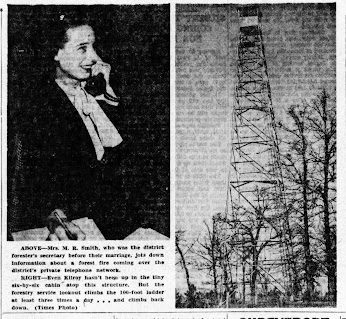Forestry and forest products are not only a valuable source of income for the state of Louisiana but also for Bossier Parish. The value-added, to Bossier Parish alone, is over fifteen million dollars per year. Value-added represents the creation of new wealth and goes into the economy through payments made to workers, interest, profits, and indirect business taxes.
It goes without saying, the need to protect our forests is a high priority. Research of forest fires began in earnest in the early 1900s on a federal level. By 1940, the Louisiana Forestry Commission was created through an amendment of the Louisiana Constitution. In the early days of the commission, look-out towers, telephone networks, and fire-fighting teams were strategically placed, providing a network of protection for each district in the state.
Bossier Parish started with two towers, the Plain Dealing tower near Rocky Mount and the Bodcau tower near Bellevue. The towers were constructed of steel and ranged between 100 and 120 feet tall, depending on the elevation of each location. Atop each tower sat a seven-square-foot observation cabin enclosed in glass on four sides. All of the towers in the fourth district were interconnected by two privately operated telephone lines, which terminated at the district headquarters in Minden.In 1946, a third tower was built on Gidden's Hill, the second-highest point in Louisiana. With Gidden's Hill being 525 feet above sea level, the 100-foot tower, on a clear day, could easily see Shreveport and Minden, and sometimes the Plain Dealing tower and the town of Springhill. A fourth and final tower went up in the Bolinger area in 1948. All of the towers operated 12 months of the year, except the Bolinger tower, which operated for six months of the year.
The fire tower watchmen were on call 24/7 except when there was a lot of rain. They typically lived in a cottage that was on the premises of or very near the tower. Because of this, there was a phone installed at the residence in addition to the tower. A typical day found the watchmen climbing up the 100-foot tower to the observation deck at least three times.
Preventing and squashing forest fires requires a group effort from citizens exercising caution when smoking or making campfires to local fire departments and citizens joining in the fight to extinguish the blaze. After a fire, an investigation takes place to determine the cause and catch those who start fires.The Louisiana Forestry Commission also promoted forestry education among the general public and in schools. Rural schools began establishing school forests and offering forestry programs, such as the Plain Dealing High School Forest, which started in 1946. They also developed nurseries to grow saplings for replanting harvested timberlands, areas destroyed by fire, and planting school forests.
Today, "the Louisiana Office of Forestry is the only state agency with statewide wildland fire-fighting capabilities detected by aircraft or are reported by the public, and are then suppressed by trained forestry crews. It involves approximately 106 wildland firefighters equipped with trucks, tractor-plows and two-way radios. These professional crews are employed year-round. Statistics show that the tractor-plow operator in the southern United States has the most hazardous wildland fire-fighting job in the nation."To learn more about forestry in Bossier Parish, visit the Bossier Parish Libraries History Center at 2206 Beckett Street, Bossier City. Be sure to follow us @BPLHistoryCenter on FB and check out our blog, http://bpl-hc.blogspot.com/. There you will find photographs to go with this article and previous articles. We also have some fun and informative videos on Tiktok; follow @bplhistorycenter to see them.
By: Amy Robertson






No comments:
Post a Comment